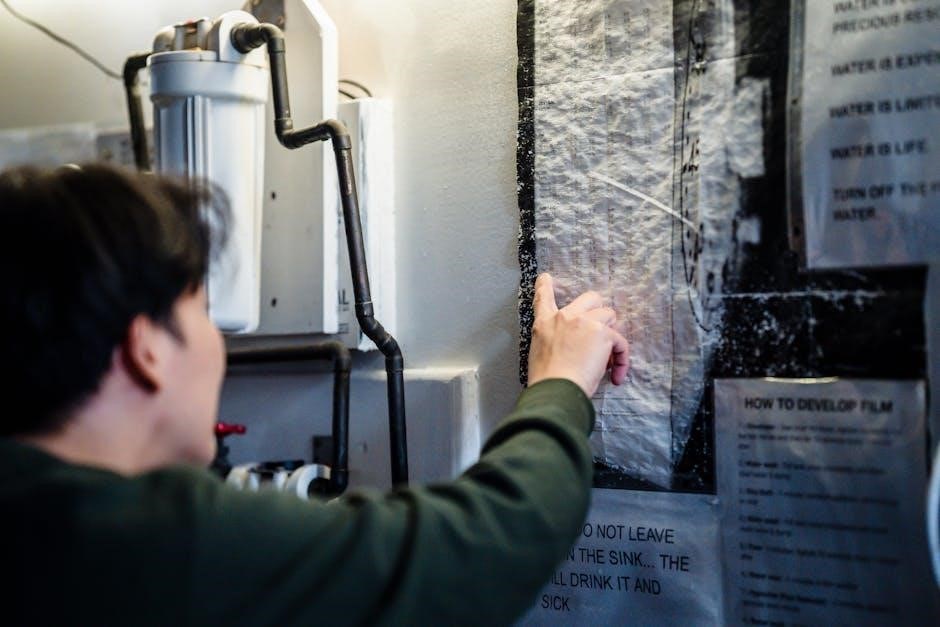The ServSafe study guide is a comprehensive resource for preparing for the ServSafe certification exam, covering food safety essentials, handling practices, and regulatory compliance.
1.1 Understanding the Importance of Food Safety Certification
Food safety certification is crucial for protecting public health and preventing foodborne illnesses. It ensures food handlers understand proper hygiene, safe food preparation, and legal requirements. Certification demonstrates a commitment to safe practices, reducing risks of contamination and foodborne outbreaks. For individuals, it enhances career opportunities and credibility in the food industry. The ServSafe certification, in particular, is a widely recognized standard for food safety knowledge and compliance.
1.2 Overview of the ServSafe Certification Program
The ServSafe certification program offers comprehensive training and exams for food safety professionals. It includes courses tailored for managers, handlers, and alcohol service providers, ensuring adherence to industry standards. The program covers essential topics like foodborne illness prevention, temperature control, and cross-contamination. Successful completion results in a nationally recognized credential, valid for several years, demonstrating expertise in maintaining safe food environments. It is accredited by ANSI and widely accepted across the food industry.

Food Safety Basics
Food safety basics include proper hygiene, handwashing, and preventing foodborne illnesses through safe handling and storage practices, ensuring a clean environment for food preparation and serving.
2.1 Personal Hygiene and Handwashing Practices
Personal hygiene and proper handwashing are critical to preventing foodborne illnesses. Food handlers must wash hands with soap and water for at least 20 seconds, especially after using the restroom, touching raw foods, or before handling ready-to-eat items. Keeping nails clean, avoiding jewelry, and refraining from touching face or hair are essential practices to maintain cleanliness and reduce contamination risks in food environments.
2.2 Understanding Foodborne Illnesses and Their Prevention
Foodborne illnesses are diseases caused by consuming contaminated food, often due to harmful bacteria, viruses, or parasites. Common pathogens include Salmonella, E. coli, and Staphylococcus. Prevention involves proper food handling, cooking, and storage. Keeping food out of the danger zone (40°F–140°F) inhibits bacterial growth. Regular handwashing, sanitizing surfaces, and separating raw and ready-to-eat foods are critical practices to reduce contamination and protect public health.

Time and Temperature Control
Proper time and temperature management is crucial for food safety, preventing bacterial growth by keeping food out of the danger zone (40°F–140°F) to ensure safe handling and storage.
3.1 Safe Food Handling and Storage Practices
Safe food handling and storage practices are essential to prevent contamination and spoilage. Separate raw and ready-to-eat foods to avoid cross-contamination. Store perishables at 40°F or below and frozen items at 0°F or below. Use sealed, labeled containers and follow the first-in, first-out rule. Regularly clean storage areas and ensure proper ventilation. Always check expiration dates and avoid storing chemicals near food to maintain a safe environment.
3.2 The Danger Zone and Its Impact on Food Safety
The danger zone, between 40°F and 140°F, is where bacteria thrive, multiplying rapidly and causing foodborne illnesses. Foods left in this range for too long can become unsafe. Understanding this critical temperature range helps prevent contamination. Use thermometers to monitor temperatures, and keep hot foods above 140°F and cold foods below 40°F. Proper handling in this zone is vital for maintaining food safety and preventing health risks.
Cross-Contamination Prevention
Cross-contamination occurs when pathogens are transferred between food, surfaces, or utensils. Preventing it requires proper handwashing, using separate tools for raw and ready-to-eat foods, and thorough cleaning.
4.1 Identifying Sources of Cross-Contamination
Identifying sources of cross-contamination is crucial for maintaining food safety. Common sources include improperly washed hands, raw food juices, unclean utensils, and unsanitized work surfaces. Food handlers can transfer pathogens to ready-to-eat foods if they don’t change gloves or wash hands after handling raw ingredients. Additionally, shared equipment or cutting boards that aren’t properly sanitized can spread contamination. Understanding these sources helps implement effective prevention strategies.
4.2 Proper Cleaning and Sanitizing Techniques
Proper cleaning and sanitizing are essential to prevent cross-contamination. Cleaning removes visible dirt and grime, while sanitizing reduces pathogens to safe levels. Use approved cleaning solutions and follow proper procedures for surfaces, utensils, and equipment. High-touch areas and utensils should be sanitized frequently, especially after handling raw foods. Regular cleaning schedules and training ensure consistent hygiene practices, protecting both food and customers from contamination risks.

Food Handler Certification Exam Details
The ServSafe Food Handler Certification Exam is a 40-question, multiple-choice test assessing basic food safety knowledge. It is not timed and requires a passing score of 75%.
5.1 Exam Format and Requirements
The ServSafe Food Handler exam consists of 40 multiple-choice questions, assessing knowledge in areas like personal hygiene, cleaning, and time-temperature control. Designed for non-management employees, it requires a 75% score to pass. The exam is not timed, allowing candidates to complete it at their own pace. This certification ensures a foundational understanding of safe food handling practices, crucial for maintaining a safe food environment.
5.2 Tips for Passing the Certification Exam
To succeed, thoroughly review the ServSafe study guide and use Quizlet flashcards for key terms. Focus on understanding time-temperature control and cross-contamination prevention. Practice with sample questions to familiarize yourself with the exam format. Ensure a solid grasp of foodborne illnesses and proper hygiene practices. Stay calm during the test and read each question carefully. Utilize online resources and practice tests to reinforce knowledge and build confidence.
Advanced Food Safety Topics
Explore managing food allergens, understanding HACCP systems, and implementing advanced food safety protocols to ensure compliance and protect consumer health effectively.
6.1 Food Allergens and Their Management
Managing food allergens is crucial for preventing severe reactions. Identify major allergens: peanuts, tree nuts, milk, eggs, fish, shellfish, wheat, and soy. Ensure proper labeling, avoid cross-contamination, and train staff to communicate with customers. Implement protocols for handling allergens, such as dedicated preparation areas and utensils. Understand emergency procedures for anaphylaxis and prioritize consumer safety to avoid legal and health risks.
6.2 HACCP and Food Safety Management Systems
HACCP (Hazard Analysis Critical Control Points) is a systematic approach to identify and control hazards in food production. It involves monitoring critical points, setting limits, and implementing corrective actions. Food safety management systems integrate HACCP with other practices to ensure compliance and consumer safety. Effective implementation prevents contamination, enhances quality, and meets regulatory requirements, making it essential for maintaining trust and safety in the food industry.

Resources for Effective Studying
Utilize official ServSafe study guides, practice tests, and flashcards for comprehensive preparation. Additional tools like Quizlet offer interactive learning to reinforce key food safety concepts and exam strategies.
7.1 Recommended Study Materials and Guides
The official ServSafe study guide is the primary resource, offering in-depth content on food safety. Supplements like practice tests and flashcards help reinforce key concepts. Digital tools, such as mobile apps and online platforms, provide interactive learning experiences. Additionally, Quizlet and other websites offer flashcards and study games. Using updated materials ensures alignment with current food safety standards and exam formats, maximizing preparation effectiveness for certification.
7.2 Online Practice Tests and Flashcards
Online platforms like ServSafe.com and Quizlet offer practice tests and flashcards to enhance exam preparation. These tools provide interactive learning, covering topics such as foodborne illnesses, time-temperature control, and cross-contamination. Flashcards with terms like “common food risk factors” help memorize key concepts. Practice tests simulate exam conditions, allowing users to assess knowledge gaps and build confidence. Utilizing these resources ensures a well-rounded understanding of food safety principles and exam readiness.
Maintaining Food Safety in Real-World Scenarios
Maintaining food safety involves practical application of knowledge, such as handling chemicals safely, managing food waste, and controlling pests to ensure a clean and safe food environment.
8.1 Handling Chemicals Safely in Food Environments
Handling chemicals safely in food environments requires proper storage, labeling, and use of personal protective equipment (PPE). Always follow the manufacturer’s instructions and ensure chemicals are kept away from food and food-contact surfaces. Training on chemical safety is essential to prevent accidents and contamination. Regularly inspect chemical containers for damage and ensure proper ventilation in areas where chemicals are used. In case of spills, follow established cleanup procedures to maintain a safe environment.
8.2 Managing Food Waste and Pest Control
Proper disposal of food waste is crucial to prevent attracting pests and maintaining a clean environment. Use sealed containers for waste storage and ensure regular cleaning and sanitizing of waste areas. Regularly inspect for signs of pests, such as rodents or insects, and seal entry points. Implement traps or pest control measures as needed. Proper waste management helps prevent contamination and ensures compliance with food safety standards and local regulations.
Additional Tips for Food Handlers
Stay informed about food safety regulations, maintain clean workspaces, and report potential hazards promptly to ensure a safe food environment for customers.
9.1 Understanding Food Safety Regulations
Understanding food safety regulations is crucial for maintaining compliance and preventing foodborne illnesses. These regulations, often mandated by local and national health authorities, outline standards for safe food handling, preparation, and storage. Familiarizing yourself with these rules ensures adherence to legal requirements and promotes a culture of safety in foodservice environments; Proper training and certification, such as ServSafe, help food handlers stay informed and updated on current regulations, safeguarding public health.
9.2 The Role of Training in Food Safety Compliance
Training is essential for ensuring food safety compliance, as it equips food handlers with the knowledge and skills needed to follow proper protocols. Regular training sessions help employees understand regulations, identify risks, and implement safe practices; Certification programs like ServSafe emphasize the importance of ongoing education to maintain high standards of food safety and protect public health. Continuous training fosters a culture of compliance and accountability in foodservice environments.
Completing the ServSafe study guide ensures a strong understanding of food safety principles, preparing individuals to handle real-world scenarios and pass certification exams confidently.
10.1 Final Preparation and Next Steps
After completing the ServSafe study guide, review key concepts, practice with flashcards, and take mock exams to reinforce learning. Stay updated on food safety regulations and best practices. Apply knowledge in real-world scenarios to ensure compliance and customer safety. Continuous learning and adherence to food safety protocols will enhance your expertise and contribute to a safer food environment.